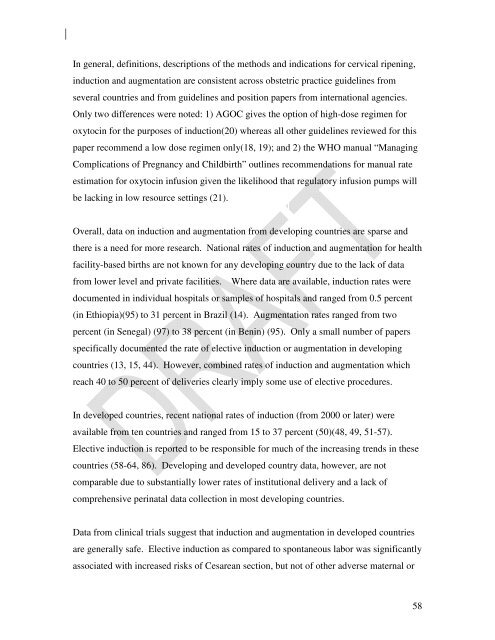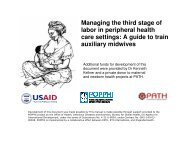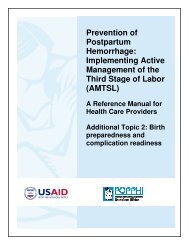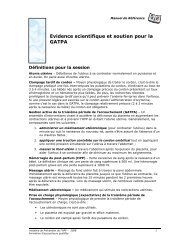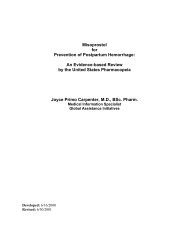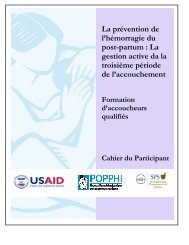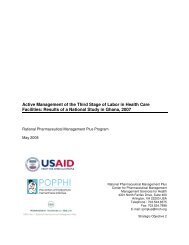Use of oxytocin and misoprostol for induction or ... - POPPHI
Use of oxytocin and misoprostol for induction or ... - POPPHI
Use of oxytocin and misoprostol for induction or ... - POPPHI
You also want an ePaper? Increase the reach of your titles
YUMPU automatically turns print PDFs into web optimized ePapers that Google loves.
In general, definitions, descriptions <strong>of</strong> the methods <strong>and</strong> indications <strong>f<strong>or</strong></strong> cervical ripening,<br />
<strong>induction</strong> <strong>and</strong> augmentation are consistent across obstetric practice guidelines from<br />
several countries <strong>and</strong> from guidelines <strong>and</strong> position papers from international agencies.<br />
Only two differences were noted: 1) AGOC gives the option <strong>of</strong> high-dose regimen <strong>f<strong>or</strong></strong><br />
<strong>oxytocin</strong> <strong>f<strong>or</strong></strong> the purposes <strong>of</strong> <strong>induction</strong>(20) whereas all other guidelines reviewed <strong>f<strong>or</strong></strong> this<br />
paper recommend a low dose regimen only(18, 19); <strong>and</strong> 2) the WHO manual “Managing<br />
Complications <strong>of</strong> Pregnancy <strong>and</strong> Childbirth” outlines recommendations <strong>f<strong>or</strong></strong> manual rate<br />
estimation <strong>f<strong>or</strong></strong> <strong>oxytocin</strong> infusion given the likelihood that regulat<strong>or</strong>y infusion pumps will<br />
be lacking in low resource settings (21).<br />
Overall, data on <strong>induction</strong> <strong>and</strong> augmentation from developing countries are sparse <strong>and</strong><br />
there is a need <strong>f<strong>or</strong></strong> m<strong>or</strong>e research. National rates <strong>of</strong> <strong>induction</strong> <strong>and</strong> augmentation <strong>f<strong>or</strong></strong> health<br />
facility-based births are not known <strong>f<strong>or</strong></strong> any developing country due to the lack <strong>of</strong> data<br />
from lower level <strong>and</strong> private facilities. Where data are available, <strong>induction</strong> rates were<br />
documented in individual hospitals <strong>or</strong> samples <strong>of</strong> hospitals <strong>and</strong> ranged from 0.5 percent<br />
(in Ethiopia)(95) to 31 percent in Brazil (14). Augmentation rates ranged from two<br />
percent (in Senegal) (97) to 38 percent (in Benin) (95). Only a small number <strong>of</strong> papers<br />
specifically documented the rate <strong>of</strong> elective <strong>induction</strong> <strong>or</strong> augmentation in developing<br />
countries (13, 15, 44). However, combined rates <strong>of</strong> <strong>induction</strong> <strong>and</strong> augmentation which<br />
reach 40 to 50 percent <strong>of</strong> deliveries clearly imply some use <strong>of</strong> elective procedures.<br />
In developed countries, recent national rates <strong>of</strong> <strong>induction</strong> (from 2000 <strong>or</strong> later) were<br />
available from ten countries <strong>and</strong> ranged from 15 to 37 percent (50)(48, 49, 51-57).<br />
Elective <strong>induction</strong> is rep<strong>or</strong>ted to be responsible <strong>f<strong>or</strong></strong> much <strong>of</strong> the increasing trends in these<br />
countries (58-64, 86). Developing <strong>and</strong> developed country data, however, are not<br />
comparable due to substantially lower rates <strong>of</strong> institutional delivery <strong>and</strong> a lack <strong>of</strong><br />
comprehensive perinatal data collection in most developing countries.<br />
Data from clinical trials suggest that <strong>induction</strong> <strong>and</strong> augmentation in developed countries<br />
are generally safe. Elective <strong>induction</strong> as compared to spontaneous lab<strong>or</strong> was significantly<br />
associated with increased risks <strong>of</strong> Cesarean section, but not <strong>of</strong> other adverse maternal <strong>or</strong><br />
58


